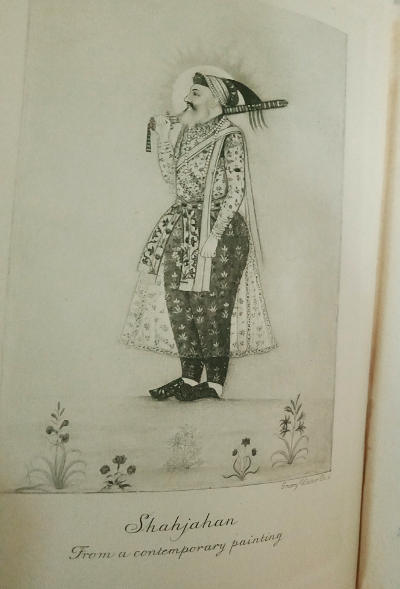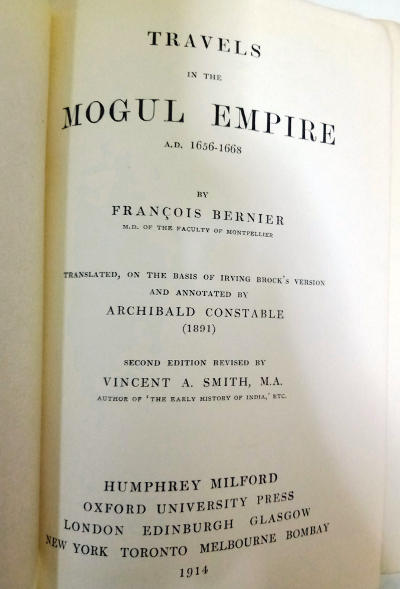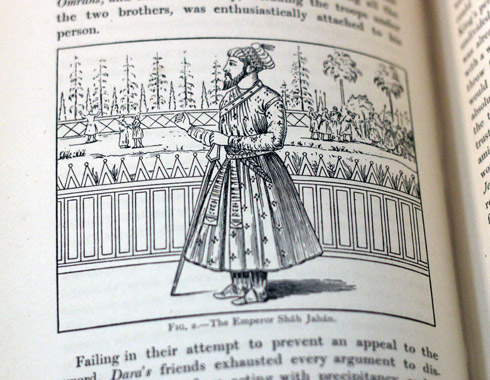An extraordinary and rare first-hand account of the Mogul Empire in South Asia. It is based on Bernier’s own extensive journeys and observations, and on information from eminent Mughal courtiers who had witnessed the events at first hand.
The book has no rival as a source-material on the condition of India during reign of Shahjahan. Political intriques and battles for the throne among his children – Dara, Sujah, Aurangzeb and Morad-Bakche has also been detailed out. The book is translated from the French by Iriving Brook which has given a vivid description of Delhi and Agra – the capital cities of the empire of the great Moguls. The original author was a physician and companion of Danishmand Khan and it was written in Delhi in July, 1663.
Every attempt that is made by scientific research or literary labour to elucidate the history and establish the truth of any record regarding India – this mighty aggregate of former kingdoms, must derive its materials from and refer to this work – because it is the only authentic source of that information which an eye witness can afford – as well as being the testimony of an European who dealt with subjects like reception of diplomats, upbringing of princes, courage of women, beauty of Kashmiri women, price of wine, living condition in Agra and Delhi, wealth of the Moguls, etc.
Contents:
Preface. 1. Chronicle of some of the principal events in the life and times of Francois Bernier. 2. Bibliography of the writings of Francois Bernier. 3. Translation of Bernier’s dedication to King Louis XIV. of France, from the 1670 Paris edition. 4. Translation of Bernier’s address to the reader, from the 1670 Paris edition. 5. An extract of a letter to Mr. H.O., from M. de Monceaux the younger, from the 1671 London edition. 6. The history of the late rebellion in the states of the Great Mogol. 7. Remarkable occurrences after the war. 8. Letter to Monseigneur Colbert concerning Hindoustan. 9. Letter to M. de la Mothe le Vayer, containing a description of Delhi and Agra. 10. Letter to M. Chapelain describing the gentiles of Hindoustan. 11. Series of nine letters to M. de Merveilles, descriptive of a march made with the camp of the Emperor Aureng-Zebe to Kachemire. 12. Replies to questions put by M. Thevenot regarding: i. Jews in Kachemire. ii. The moisson or periodical rains in the Indies. iii. The regularity of the winds and currents in the Indies. iv. The fertility, wealth and beauty of the kingdom of Bengale. v. The periodical rising of the Nile. 13. A memorandum, omitted to be inserted in my first work, to complete the map of Hindoustan, and make known the revenues of the great Mogol. 14. Abstract of the king’s licence, from the 1670 Paris edition. Appendices: 1. Regarding Dryden’s tragedy of Aureng-Zebe. 2. On the identity of the ‘Great Mogul’s diamond’ with the Koh-i-nur. 3. Tavernier’s description of the peacock throne of the Great Mogul. 4. Note on the letter to Monseigneur Colbert concerning the absorption of the precious metals in India. 5. Some particulars relating to Mr. H[enry] O[uldinburgh]. Index.
About Francois Bernier:
François Bernier (1625 – 22 September 1688) was a French physician and traveller. He was born at Joué-Etiau in Anjou. He was the personal physician for the elder son of Shah Jahan for Prince Dara Shikoh for around 12 years during his stay in India.
A son of a farmer, François Bernier, was orphaned very young and was cared for by his uncle. In 1652 during a prolonged stay with Gassendi in the south of France, he managed to become a medical doctor on the strength of a speed-course at the famous Faculté de Montpellier: an intensive three-month course gave the medical degree providing one did not practice on French national territory.
Liberated from his ties to France by the death of Gassendi in 1655, he set out on his twelve-year journey to the East, at 36 years of age: Palestine, Egypt, one year in Cairo, Arabia, and an attempt to enter Ethiopia which was frustrated by civil war in the interior. In 1658 he debarked at Surat in India, in Gujarat state. Attached at first and for a short while to the retinue of Dara Shikoh—the history of whose downfall he was to record—he was installed as a medical doctor at the court of Aurangzeb, the last of the great Mughal emperors.
A tour of inspection by Aurangzeb (1664–65) gave Bernier the opportunity to describe Kashmir, the first and for a long time the only European to do so. In: “Voyages de F. Bernier (angevin) contenant la description des Etats du Grand Mogol, de l’Indoustan, du royaume de Kachemire” (David-Paul Maret ed., Amsterdam, 1699). He subsequently visited the other extreme of the empire in Bengal. European medical training was highly esteemed amongst the Mughal and gave him access to all ranks of the court, even on medically required occasions to the Emperor’s harem.
After his return from Kashmir, he traveled around on his own, meeting with Jean-Baptiste Tavernier in Bengal and—while preparing for a journey to Persia at Surat—with Jean Chardin, that other great traveler in the Orient (1666).
He returned once more to Surat (1668) to write a memoir on Indian commerce for the use of Jean-Baptiste Colbert (who recently had founded La Compagnie des Indes Orientales). In 1669 Bernier left India for Paris, to stay.
In 1671 he almost was jailed for writing in defense of the ideas of René Descartes, against whom a judicial arrest had been issued—an exploit he followed with an “Abrégé de la Philosophie de Gassendi”, also not a subject to arouse official approval (1674).
Meanwhile he was a favored guest at some of the great literary salons, for example that of Marguerite de la Sablière, who introduced him to Jean de La Fontaine; or at that of Ninon de Lenclos.






